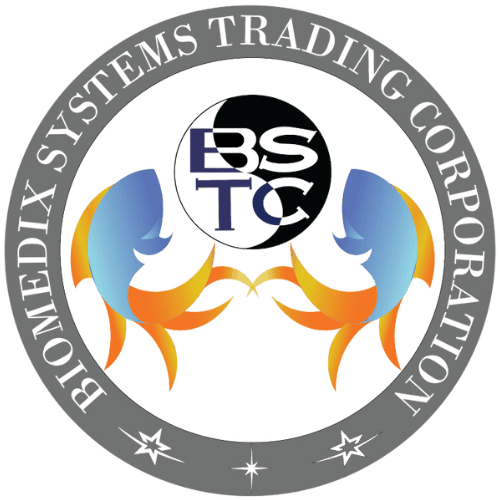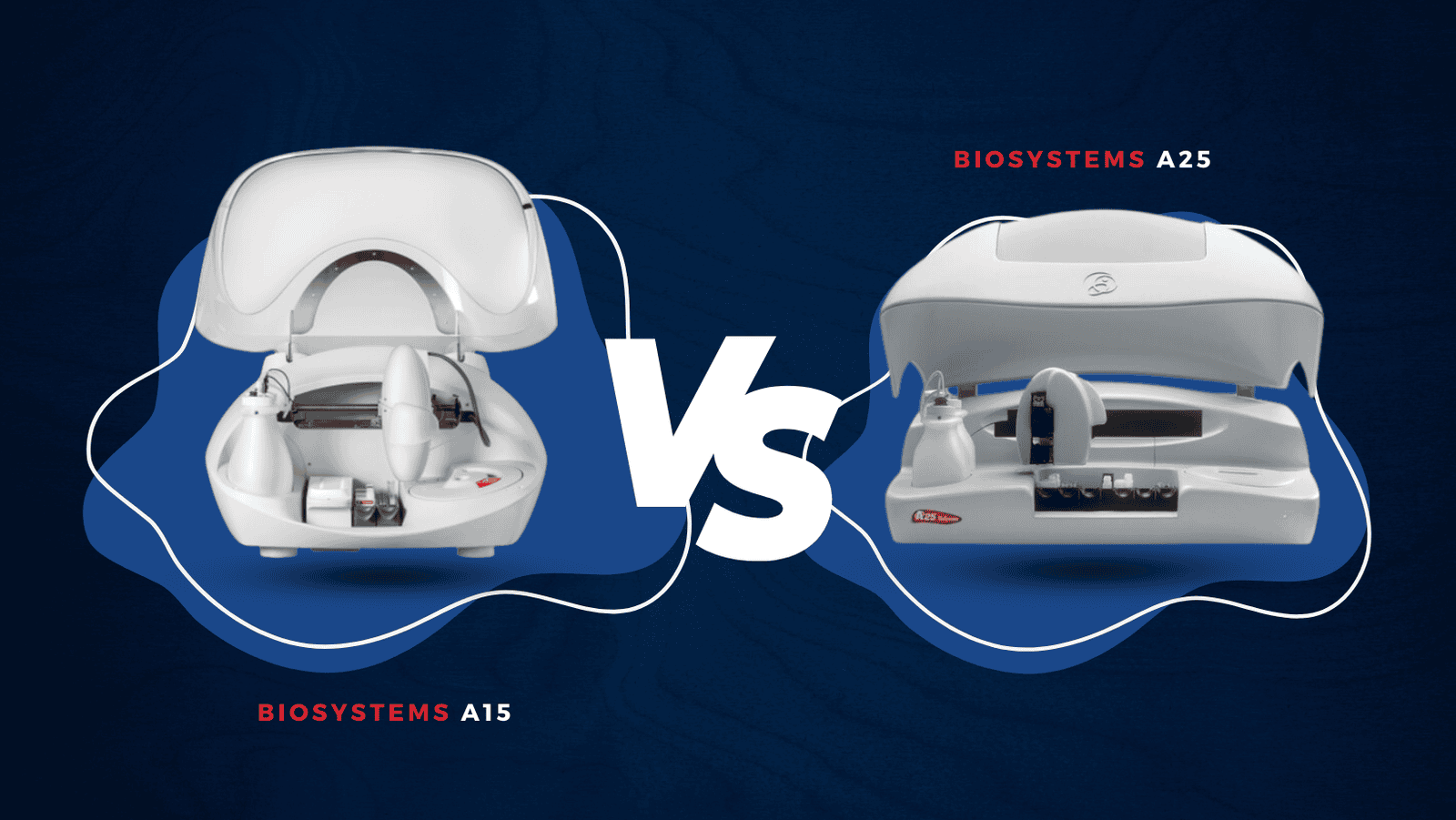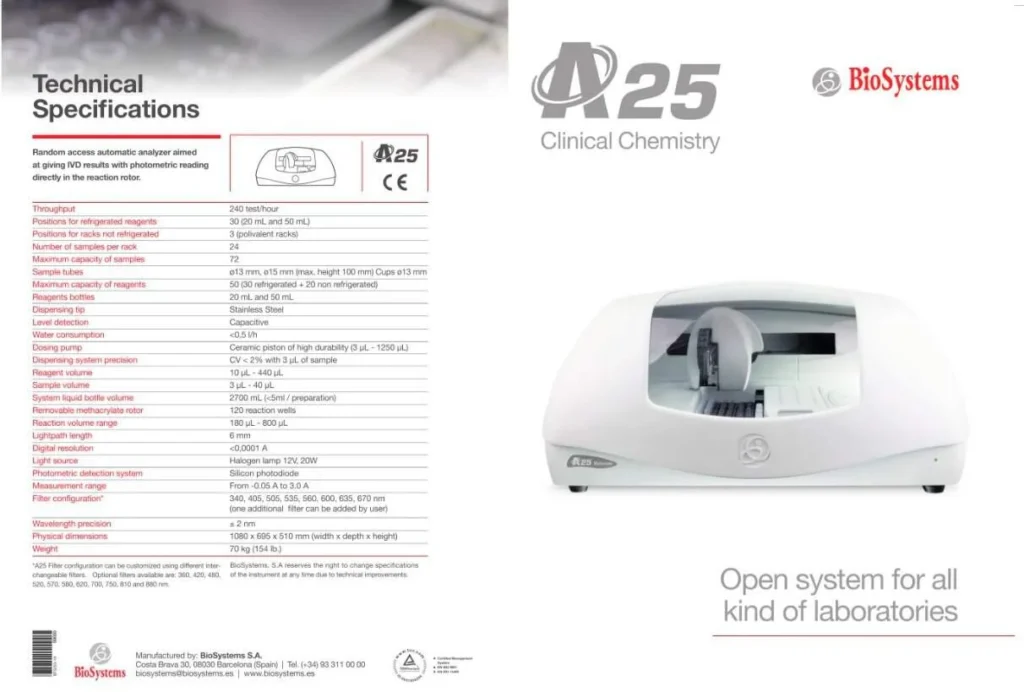


Selecting the right biochemistry analyzer is a critical decision for any laboratory or clinical practice. The right choice impacts operational efficiency, diagnostic accuracy, and patient outcomes. Two prominent models on the market are the BioSystems A15 and A25. Both are designed to meet the diverse needs of modern laboratories, but they cater to different operational scales and budgets. This comprehensive comparison will guide you through the key features, performance metrics, and practical insights to help you make an informed decision.

The BioSystems A15 is a high-quality, versatile biochemistry analyzer ideal for modern laboratories. Designed to combine utility and functionality, the A15 boasts a compact size and user-friendly interface. It offers unmatched analysis capabilities, processing up to 60 samples simultaneously and delivering speeds of up to 400 tests per hour. This makes it perfect for laboratories with varying workloads and the need for diverse testing methods. Its efficient test administration and broad applicability ensure that the A15 meets the needs of any busy laboratory setting.
The A15 biochemistry analyzer is designed for small to medium-sized laboratories. Its compact design allows it to fit easily on a lab bench, making it ideal for labs with limited space.
The A15 is known for being budget-friendly, offering essential features without the higher costs associated with larger, more advanced models.
With intuitive software and user-friendly interfaces, the A15 biochemistry analyzer is designed to be easy to operate, requiring minimal training for lab technicians.
Despite its smaller size, the A15 can handle a wide variety of tests, making it versatile for different types of biochemical analysis.
The A15 is engineered for minimal maintenance, incorporating features that decrease the need for frequent and intricate servicing. This makes it a dependable choice for laboratories requiring consistent performance with minimal downtime.

In contrast, the BioSystems A25 represents the pinnacle of biochemistry analyzer technology, offering advanced features and exceptional automation. The A25 provides maximum convenience with its intuitive interface and touchscreen operation. Its accuracy within a broad dynamic range demonstrates sensitivity and specificity comparable to the best in the market. By automating much of the workflow, the A25 handles complex biological processes with minimal human intervention, significantly reducing the risk of errors associated with manual operation. This makes it an excellent choice for laboratories and clinical practices seeking top-tier performance and reliability.
The A25 handles a greater sample volume than the A15, making it ideal for larger labs needing fast and efficient processing.
The A25 includes advanced features such as automated sample handling, enhanced data management, and integration capabilities with laboratory information systems (LIS).
Built with robust components and advanced diagnostics, the A25 offers greater reliability, reducing downtime and ensuring consistent performance.
Like the A15, the A25 is designed to be energy-efficient, helping laboratories reduce their operational costs and environmental footprint.
Distinct differences in performance and functionality can be seen when comparing BioSystems A15 with A25. Both biochemistry analyzers have high throughput and sample capacity, but the A25 is superior in terms of analytical sensitivity and automation. These enhanced qualities, however, come at a greater initial cost and might be more applicable to laboratories that carry out large volumes of tests. On the other hand, if you are working on a tight budget or operating a small laboratory, the A15 can offer an economical alternative without sacrificing quality.

When choosing between BioSystems A15 and A25 biochemistry analyzers, there are several factors that laboratory professionals and clinical business owners should evaluate based on their specific needs. These include test volume, assay complexity, and budget constraints, among others. Additionally, future scalability and expansion opportunities must also be considered for long-term viability.
Real-world experiences provide valuable insights into the performance and reliability of BioSystems A15 and A25. Laboratories implementing these biochemistry analyzers have reported significant improvements in efficiency, accuracy, and overall satisfaction. Whether it's the versatility of the A15 or the automation capabilities of the A25, these biochemistry analyzers have proven their value in diverse laboratory settings, delivering superior results and driving operational excellence.
Choosing the best biochemistry analyzer for your lab or clinical practice is a crucial decision. The BioSystems A15 and A25 biochemistry analyzers each have distinct strengths and weaknesses across various performance metrics. Analyzing these factors helps laboratory professionals and clinical business owners identify which biochemistry analyzer aligns best with their specific needs and priorities.
By leveraging this comprehensive comparison, decision-makers can make informed choices that optimize laboratory efficiency and performance. Investing strategically in your laboratory infrastructure ensures improved efficiency, enhanced accuracy in diagnostic testing, and ultimately, better outcomes for patients.
Related Reading: The Clinical Chemistry Analyzer: Its History and Development
Planning on BioSystems A15 or A25 for your lab setup?